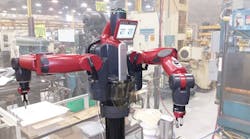Parents do not necessarily have the most up-to-date information or perspective on manufacturing and the opportunities available, according to a study released last week by SME, an organization that serves the manufacturing industry by promoting advanced manufacturing technology and developing a skilled workforce.
“The landscape in advanced manufacturing has evolved,” said Jeffrey Krause, CEO of SME. “A serious misconception is that manufacturing is dirty, dark or dangerous; and isn’t seen as an optimal career choice. The reality is far from that.”
“Manufacturing today is an advanced, high-value industry that represents innovation and technology," Krause added. "The survey results demonstrate that we need to show that manufacturing careers can be exciting, stimulating and very rewarding.”
Highlights of the survey include:
- More than 20% of parents surveyed view manufacturing as an outdated and/or dirty work environment.
- Half of all respondents do not see manufacturing as an exciting, challenging or engaging profession.
- Nearly one-quarter of parents surveyed do not feel that manufacturing is a well-paying profession.
Dispelling the myths
- Many of today’s manufacturing environments look more like clean rooms, with laboratory-like settings.
- Manufacturing offers career opportunities for every education level ranging from skilled trades that require a high school diploma or GED to engineers, designers and programmers with bachelor’s and master’s degrees and researchers and scientists with PhDs.
- Technological advancements are yielding well-paying careers – the average U.S. manufacturing worker makes $77,506.
- The use of 3D design and computer-aided engineering software is attracting students interested in non-traditional careers such as game design and animatronics.
Other industry truths
- Many advances are taking place in additive manufacturing. That includes 3D printing, which has been used to create everything from aircraft parts to custom medical devices. The global 3D printing market is expected to grow from $1.6 billion in 2015 to $13.4 billion in 2018.
- For every $1 spent in manufacturing, another $1.37 is added to the economy – the highest multiplier effect of any economic sector.
- An estimated 3.5 million manufacturing jobs will become available in the next 10 years – but without the right skilled workers for the jobs, an estimated 2 million of those jobs could go unfulfilled.




